There is a picture circulating of one coach being lifted.
There are a couple of pictures of one of the carriages being lifted in the Salisbury Journal (pasted below):

There is a picture circulating of one coach being lifted.

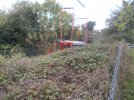
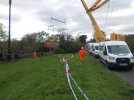
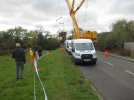
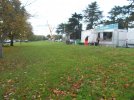

It's a common phrase in accident investigation — both air and rail.asking if they were going to Eastleigh, elicited the reply, 'no they are going to quarantine' Is that an official railway term?
I expect that “quarantine” in this context also implies RAIB want another look at them. There’ll probably still be more useful information to be gathered without the risk of carriages sitting at an angle at the tunnel mouth.It's a common phrase in accident investigation — both air and rail.
It's standard after a major accident to quarantine the vehicles involved: RAIB have said their investigation will include looking at "the status and performance of the braking, wheel slide protection and sanding systems on train 1L53" and "the behaviour of both trains during and following the collision"; obviously that is easier in a secure environment. As an example, the vehicles involved at Carmont were quarantined at the former Glasgow Works after the accident.I expect that “quarantine” in this context also implies RAIB want another look at them. There’ll probably still be more useful information to be gathered without the risk of carriages sitting at an angle at the tunnel mouth.
Off to Long Marston is my understanding.asking if they were going to Eastleigh
Torching the coupling bars before attempting to pull them out might have been a good idea so they aren't trying to pull 4 connected and wedged vehicles out at the same time...158762 is back at SPM, moved under its own power last night.
They’ve so far recovered only the London End vehicle off 159102; the remaining vehicles have been somewhat stubborn. I understand that further attempts with more destructive methods will be attempted from tomorrow (cutting bits off it to free it in lay terms)
I assume the rest of 159102 will be scrapped on site?
I'm sure the professionals on sight are doing it the best way possible whilst working with what they have been given.Torching the coupling bars before attempting to pull them out might have been a good idea so they aren't trying to pull 4 connected and wedged vehicles out at the same time...
A Kirow might also be useful to right the 159 middle vehicle at least.
Having the 59 on the other track might have been more helpful too!

Salisbury train crash | Network Rail preparing for ‘heavy refurbishment’ of track as trains lifted away | New Civil Engineer
While a final plan is yet to be drawn up, Network Rail has revealed that the line will be closed for at least another week following Sunday's collision.www.newcivilengineer.com
Network Rail has revealed that it will need to carry out a “heavy refurbishment” at the site of the Salisbury train crash.
While a final plan is yet to be drawn up, Network Rail has revealed that the line will be closed for at least another week following Sunday's collision.
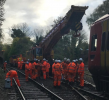
It adds: “We will have to carry out what is called a “heavy refurbishment” on the junction where the accident happened, which is one stop short of a complete replacement.
“The advantage is we don’t have to dig everything up and start again with new components, but it’s still a big job.
“At the same time, we’re investigating potentially laying new track in Fisherton Tunnel, and we'll know more about that later this week.”
Network Rail is also inspecting the signalling equipment in the area which was struck during the collision.
Isn’t using “destructive methods” to remove them near enough scrapping them on site? I appreciate that may not be the official term for it and that the remains will be heading to Long Marston rather than a scrapyard but in layman’s terms that’s pretty much what it is - to many of us a train is “scrapped” once it’s been dismantled to a significant extent, which is what removal by destructive methods implies.No, each vehicle will be removed.
Given where it is (ie next to the welfare prefab and within the cordon, the owner/staff member is wearing a hi viz) it'll have been rented specifically for the staff.Good on that burger van owner! It's a win win situation for them and also for the workers at the location
I suspect that the engineering staff there already know what they're doing. They'll also want it out with the minimum of further damage causing, so laying it on its side on any form of sled and dragging it out isn't an option.Rather than using a loco to try to drag the DMU cars out of the tunnel using traction alone, they really need a powerful and strong winch. Which in turn needs to be fixed to something very heavy. Such as a topped and tailed ballast train.
It may also be worthwhile putting a makeshift wood sled on the adjacent line and then trying to lower the car that is at an angle onto it, rather than trying to pull it out in it’s current position. Of course, that assumes there is enough space in the tunnel to do this.
I think it should be interpreted as “don’t worry about causing further damage”, rather than “destroy them on site”…Isn’t using “destructive methods” to remove them near enough scrapping them on site? I appreciate that may not be the official term for it and that the remains will be heading to Long Marston rather than a scrapyard but in layman’s terms that’s pretty much what it is - to many of us a train is “scrapped” once it’s been dismantled to a significant extent, which is what removal by destructive methods implies.
They did indeed use a train, I guess it makes sense to try the more simple options first before trying more complicated, expensive and destructive methods.i was also caught out by the photo, i did wonder why they used a train to pull another out of some wreckage rather than a crane or something
The wheelmarks dug into the track from the 59 on the second video are horrific.
Using the nylon strap seems a little "elastic" to me but I guess heavy duty chains are no longer HASAW approved. Seeing 59003 bounce on the end of the strap is a little unnerving but the guys on the ground are professionals and know what they are doing.There will come a point where it will be easier to get them out in chunks (especially the front 159 car) but it should be possible to free the cars and then drag them out. Trying to pull them out in the manner they have attempted seems a bit too basic for me - I’m more used to seeing jack and pack, separate and move.
It will be interesting to see what they do next.
Not from the scene, the still image from that video was deleted and and comments related to it not being from the scene also deletedThe wheelmarks dug into the track from the 59 on the second video are horrific.
Not UK infrastructure, irrelevant.The wheelmarks dug into the track from the 59 on the second video are horrific.
In the 1980s a Class 47 ran down an embankment and was recovered by quite a collection of its class mates, and a clever arrangement of steel cables. Was it 47 522 at Forteviot in July 1982?I did wonder why they used a train to pull another out of some wreckage rather than a crane or something
